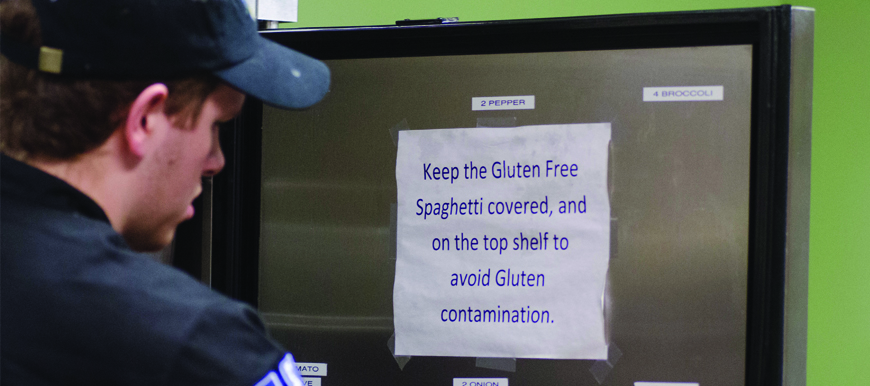Food or foe? Dining services seeks options for students with food allergies
Imagine an entire banquet table full of delicious breads, pastas and tree nuts, but eating from it would be deadly. For some Utah State University students, this scenario is not imaginary.
Fallon Rowe, a freshman majoring in geology, faces this reality on a daily basis.
“I’m allergic to walnuts, pecans, coconut and hazelnut. I’m also intolerant of gluten, fish and seafood,” Rowe said. “The nut allergies will give me anaphylaxis, which is a serious allergic reaction so I always carry an EpiPen with me.”
Rowe, who lives on campus, was required to buy a traditional meal plan from the university. Despite the efforts USU’s Dining Services program has put forth toward catering to students with food allergies, Rowe said eating safely on campus can be challenging.
“I feel that most Dining Services employees aren’t aware enough of those of us with food allergies,” she said. “I have had various allergic reactions throughout the year as a result of this, when I would eat food that regularly doesn’t give me any problems, but something else contaminated it and triggered a reaction.”
Director of Dining Services Alan Andersen feels the pressure of ensuring the safety of over 1,400 students who currently have meal plans. Of those 1,400 students, he said the staff works personally with around a dozen students who suffer from severe food allergies.
“What we want to create is a relationship where they can feel comfortable, that they can walk in and say, ‘Hey, Rich, can I eat this? Can I eat that?’ That type of thing, you know, because there is so much variety,” Andersen said.
Catering to meet the needs of students with dietary restrictions is a demanding challenge for Dining Services. Andersen said finding a variety of safe food options for students, let alone avoiding cross-contamination in a self-serve setting, is an issue they are constantly working to improve.
One of the most common types of food allergies that Dining Services addresses is Celiacs Disease and gluten intolerance.
“Gluten-free is probably the biggest one we work with,” Andersen said. “It’s much bigger, and it’s more commonly diagnosed. There are a lot of reasons for its growth, and we are seeing that growth.”
For Melia Hawkins, a freshman majoring in psychology, any amount or trace of gluten, if consumed, causes her to become ill. However, with the help of Dining Services, the one-on-one tactic has been helpful in providing healthy and safe food options.
“The head of the Dining Services met personally with me and took me into the Marketplace and showed me what I could eat at each station,” Hawkins said.
Dining Services offers many options for students with gluten-free needs. In addition to the personal guidance from the staff, there are special refrigerators designated for specifically gluten-free food items as well as signs on the menu to help students know what is and is not safe to eat.
“At each of the stations on their menu signs, they provide symbols to inform people with food allergies what is safe for them to eat based on their allergy,” Hawkins said. “They also have a dedicated gluten-free and dairy-free fridge for some special products like desserts for people with gluten and dairy issues.”
One problem Dining Services runs into with the specialized refrigerators is that some students like to take gluten-free food for dieting purposes when they don’t have an allergic health restriction.
Rowe said the allergy-free fridge was removed from public access so other people wouldn’t be as prone to take their food.
“It’s frustrating for those of us with allergies because we don’t have an option like the people who just do it as a diet,” Rowe said.
To help with this problem, Rowe suggested that Dining Services provide a special access card to ensure the food is more easily accessible to those with allergies.
“Even just adjusting the ‘seven meals a week’ meal plan to include cash equivalency would be helpful,” Rowe said, “because it’s a lot easier to avoid allergens when the food is packaged with an ingredients list, like the food at the Quick Stop.”
One of Dining Service’s core values is continuous improvement, according to its webpage. For Andersen, the biggest challenge is getting students to provide feedback.
“We can’t fix what we don’t know is broken, and so we’re really open to that feedback, and anytime we hear stuff like that we really work on it,” he said. “We’re willing to do anything to take care of them, but we’ve just got to know.”
— alyssa.hawkins@aggiemail.usu.edu
Twitter: @_alyssahawkins

